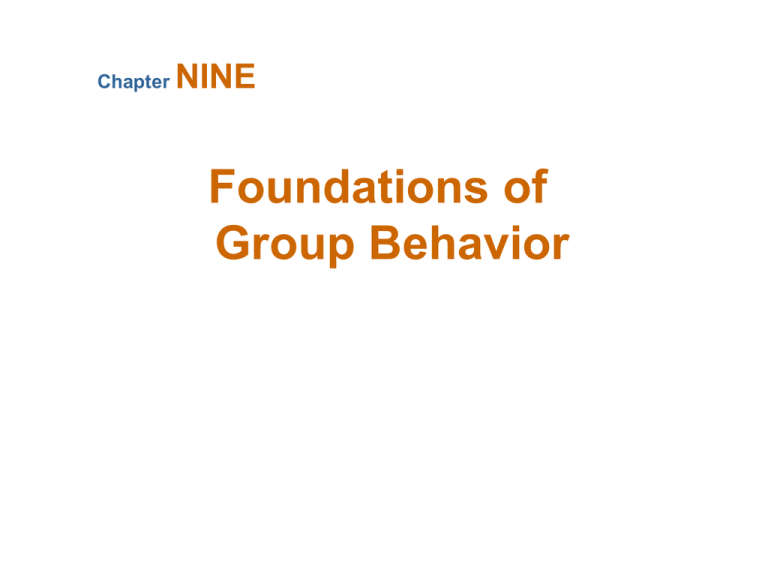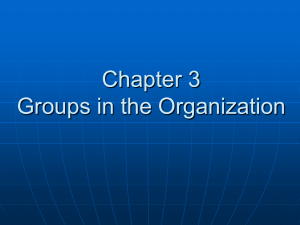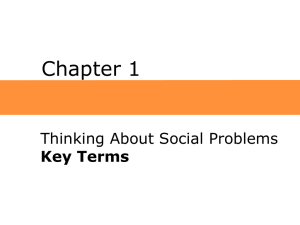Foundations of Group Behavior Chapter NINE
advertisement

Chapter NINE Foundations of Group Behavior Defining and Classifying Groups Group(s) Two or more individuals interacting and interdependent, who have come together to achieve particular objectives Formal Group Informal Group A designated work group defined by the organization’s structure A group that is neither formally structured nor organizationally determined; appears in response to the need for social contact Defining and Classifying Groups (cont’d) Command Group Task Group A group composed of the individuals who report directly to a given manager Those working together to complete a job or task Interest Group Friendship Group Those working together to attain a specific objective with which each is concerned Those brought together because they share one or more common characteristics Why People Join Groups • Security • Status • Self-esteem • Affiliation • Power • Goal Achievement The Five-Stage Model of Group Development Forming Stage The first stage in group development, characterized by much uncertainty Storming Stage The second stage in group development, characterized by intragroup conflict Norming Stage The third stage in group development, characterized by close relationships and cohesiveness …Group Development (cont’d) Performing Stage The fourth stage in group development, when the group is fully functional Adjourning Stage The final stage in group development for temporary groups, characterized by concern with wrapping up activities rather than performance Stages of Group Development E X H I B I T 9–2 An Alternative Model: Temporary Groups with Deadlines Punctuated-Equilibrium Model Temporary groups under time constrained deadlines go through transitions between inertia and activity—at the halfway point, they experience an increase in productivity. Sequence of Actions 1. Setting group direction 2. First phase of inertia 3. Half-way point transition 4. Major changes 5. Second phase of inertia 6. Accelerated activity The Punctuated-Equilibrium Model E X H I B I T 9–3 Group Properties Roles Norms Status Cohesiveness Group Properties—Roles Role(s) A set of expected behavior patterns attributed to someone occupying a given position in a social unit Role Identity Certain attitudes and behaviors consistent with a role Role Perception An individual’s view of how he or she is supposed to act in a given situation Group Properties—Roles (cont’d) Role Expectations How others believe a person should act in a given situation Psychological Contract An unwritten agreement that sets out what management expects from the employee and vice versa Role Conflict A situation in which an individual is confronted by divergent role expectations Group Properties—Norms Norms Acceptable standards of behavior within a group that are shared by the group’s members Classes of Norms • Performance norms • Appearance norms • Social arrangement norms • Allocation of resources norms Group Norms and the Hawthorne Studies A series of studies undertaken by Elton Mayo at Western Electric Company’s Hawthorne Works in Chicago between 1924 and 1932 Research Conclusions – Worker behavior and sentiments were closely related. – Group influences (norms) were significant in affecting individual behavior. – Group standards (norms) were highly effective in establishing individual worker output. – Money was less a factor in determining worker output than were group standards, sentiments, and security. Group Properties—Norms (cont’d) Conformity Adjusting one’s behavior to align with the norms of the group ASCH STUDY Reference Groups Important groups to which individuals belong or hope to belong and with whose norms individuals are likely to conform EXHIBIT 9–4 Group Properties—Norms (cont’d) Deviant Workplace Behavior Antisocial actions by organizational members that intentionally violate established norms and result in negative consequences for the organization, its members, or both Group norms can influence the presence of deviant behavior. Typology of Deviant Workplace Behavior Category Examples Production Leaving early Intentionally working slowly Wasting resources Property Sabotage Lying about hours worked Stealing from the organization Political Showing favoritism Gossiping and spreading rumors Blaming coworkers Personal Aggression Sexual harassment Verbal abuse Stealing from coworkers Source: Adapted from S.L. Robinson, and R.J. Bennett. “A Typology of Deviant Workplace Behaviors: A Multidimensional Scaling Study,” Academy of Management Journal, April 1995, p. 565. E X H I B I T 9–5 Group Properties—Status Status: A socially defined position or rank given to groups or group members by others Power over Others Ability to Contribute Personal Characteristics Norms and Interaction Group Member Status Other things influencing or influenced by status Status Inequity National Culture Group Properties—Size Social Loafing The tendency for individuals to expend less effort when working collectively than when working individually Performance Other Conclusions • Odd number groups do better than even. • Groups of 5 to 7 perform better overall than larger or smaller groups. Group Size Group Properties—Cohesiveness Cohesiveness Degree to which group members are attracted to each other and are motivated to stay in the group Increasing Group Cohesiveness 1. 2. 3. 4. Make the group smaller. Encourage agreement with group goals. Increase time members spend together. Increase group status and admission difficultly. 5. Stimulate competition with other groups. 6. Give rewards to the group, not individuals. 7. Physically isolate the group. Relationship Between Group Cohesiveness, Performance Norms, and Productivity E X H I B I T 9-7 S. Adams, Build a Better Life by Stealing Office Supplies (Kansas City MO: Andrews & McMeal, 1991), p. 31. Dilbert reprinted with permission of United Features Syndicate, Inc. E X H I B I T 9–8 Group Decision Making Decision Making – Large groups facilitate the pooling of information about complex tasks. – Smaller groups are better suited to coordinating and facilitating the implementation of complex tasks. – Simple, routine standardized tasks reduce the requirement that group processes be effective in order for the group to perform well. Group Decision Making (cont’d) Strengths – More complete information – Increased diversity of views – Higher quality of decisions (more accuracy) – Increased acceptance of solutions Weaknesses – More time consuming (slower) – Increased pressure to conform – Domination by one or a few members – Ambiguous responsibility Group Decision Making (cont’d) Groupthink Phenomenon in which the norm for consensus overrides the realistic appraisal of alternative course of action Groupshift A change in decision risk between the group’s decision and the individual decision that member within the group would make; can be either toward conservatism or greater risk Symptoms of the Groupthink Phenomenon Group members rationalize any resistance to the assumptions they have made. Members apply direct pressures on those who express doubts about shared views or who question the alternative favored by the majority. Members who have doubts or differing points of view keep silent about misgivings. There appears to be an illusion of unanimity. Group Decision-making Techniques Interacting Groups Typical groups, in which the members interact with each other face-to-face Nominal Group Technique A group decision-making method in which individual members meet face-to-face to pool their judgments in a systematic but independent fashion Group Decision-making Techniques Brainstorming An idea-generation process that specifically encourages any and all alternatives while withholding any criticism of those alternatives Electronic Meeting A meeting in which members interact on computers, allowing for anonymity of comments and aggregation of votes Evaluating Group Effectiveness TYPE OF GROUP Effectiveness Criteria Interacting Brainstorming Nominal Electronic Number and quality of ideas Low Moderate High High Social pressure High Low Moderate Low Money costs Low Low Low High Speed Moderate Moderate Moderate Moderate Task orientation Low High High High Potential for interpersonal conflict High Low Moderate Low Commitment to solution High Not applicable Moderate Moderate Development of group cohesiveness High High Moderate Low E X H I B I T 9–9 Chapter Check-up: Groups True or False: The Punctuated Equilibrium Model suggests that groups have an equilibrium, but that equilibrium will be punctuated at the halfway point. But, after the punctuation, the group will return to the equilibrium it had prior to the punctuation. False. The first part is true, but the second sentence is false. After the punctuation, the group will have a new equilibrium of increased productivity. Chapter Check-Up: Groups List two drawbacks of brainstorming and two pluses of the Nominal Group Decision-making Technique. Compare your answers with your neighbor and discuss which one you would use for a group project in this class and why. Chapter Check-up: Groups Lorraine is a non-traditional student (she’s 51 years old) and is working in a group for a class project. They keep turning to her for the answers to questions. Which of the following might the group have that is driving Lorraine’s experience? Groupthink Groupshift Role Conflict Role Expectations The group may have role expectations of Lorraine—e.g., because she’s older, she should be the wise one and know the answers like a parent should.








